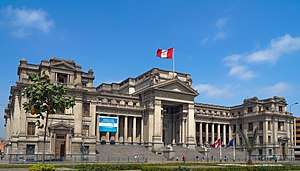Supreme Court of Peru
The Supreme Court of Justice is the highest judicial court in Peru. Its jurisdiction extends over the entire territory of the nation. It is headquartered in the Palace of Justice in Lima.
| Supreme Court of Peru | |
|---|---|
| Corte Suprema de Justicia | |
 The Palace of Justice in Lima. | |
| Established | 1825 |
| Location | Lima |
| Coordinates | 12.057595°S 77.03532°W |
| Composition method | Selected by the National Board of Justice. |
| Authorized by | Constitution of Peru |
| Judge term length | 70 years old. At that age, the National Board of Justice can keep the judges for an additional term of seven years, following the same process established for the appointment. The seven-year extension can be repeated indefinitely. |
| Number of positions | 15[1] |
| Annual budget | S/ 2270 million |
| Website | http://www.pj.gob.pe/ |
| President of the Supreme Court | |
| Currently | José Luis Lecaros |
| Since | 2 January 2019 |
 |
|---|
| This article is part of a series on the politics and government of Peru |
| Constitution |
|
|
|
|
Autonomies
|
|
|
|
|
|
|
Structure
The supreme court is composed of three Supreme Sectors:
- Civil Sector: Presides over all topics related to civil rights and commercial law.
- Criminal Sector: Presides over all topics relating to criminal law
- Constitutional and Social Sector: Presides over all topics relating to constitutional rights and labor law
Integrated into the Supreme Court are the Supreme Speakers and Supreme Provisionary Speakers, who substitute the Supreme Speakers in case of absence. The Supreme Speakers are distributed into each one of the Supreme Sectors that the law establishes. The President of the Supreme Court and the Chief Speaker of the Office of the Control of the Magistrature are not integrated into any Supreme Sector. The Supreme Court consists of three permanent Supreme Sectors (Civil, Criminal, and Constitutional and Social). Each Supreme Sector has five Supreme Speakers who elect a president within each other.
Mechanisms
The Constitution guarantees the right to the double instance, which the Supreme Court recognizes. In event that this right is failed, the appeals in the processes that interpose before the Superior Sectors, or it is brought before the Supreme Court. The Abrogation doctrine is also recognized by this court.
Members
President
- José Luis Lecaros Cornejo
Justices
- Francisco Távara Córdova
- Vicente Rodolfo Walde Jaúrequi
- César San Martín Castro
- Victor Roberto Prado Saldarriaga
- Duberlí Rodríguez Tineo
- Josué Pariona Pastrana
- Ana María Aranda Rodríguez
- Javier Arévalo Vela
- Jorge Luis Salas Arenas
- Elvia Barrios Alvarado
- Janet Ofelia Tello Gilardi
- Ángel Henry Romero Díaz
- Hector Enrique Lama More
- Martín Alejandro Hurtado Reyes
- Carlos Giovanni Arias Lazarte
- Aldo Martín Figueroa Navarro
- Mariem Vicky de la Rosa Bedriñana
.svg.png)